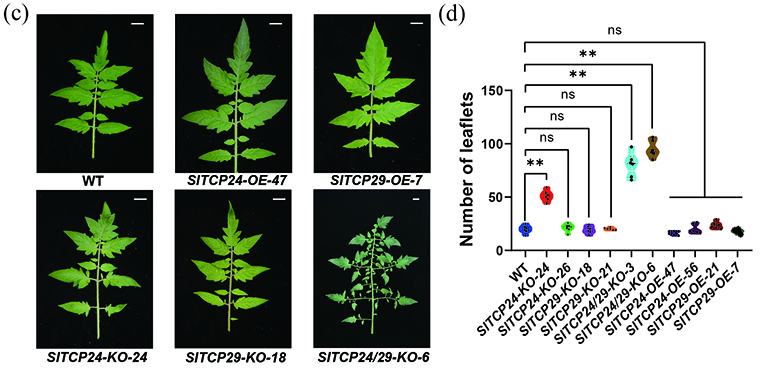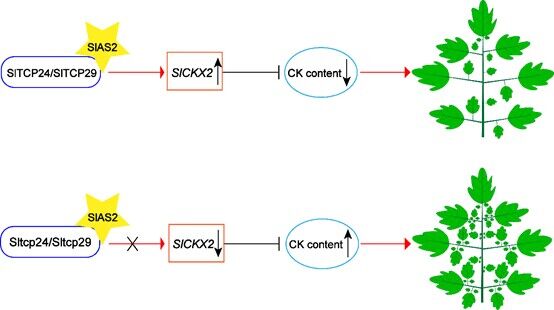我校揭示SlTCP24和SlTCP29 转录因子协同调控番茄复叶发育的分子机制
南湖新闻网讯(通讯员 胡国煜)近日,我校番茄团队王涛涛、张俊红教授课题组揭示了SlTCP24和SlTCP29 转录因子协同调控番茄复叶发育的分子机制,研究以“SlTCP24 and SlTCP29 synergistically regulate compound leaf development through interacting with SlAS2 and activating transcription of SlCKX2 in tomato”为题发表在New Phytologist上。
植物叶片的型态多种多样,总的来说分为单叶和复叶。叶型是影响植物株型的重要因子,叶片形态结构在逆境胁迫应答中也起着重要的作用,因此植物叶型与农作物的产量密切相关。番茄叶片形态由简单到复杂,是一类研究复叶发育的模式植物。利用番茄研究复叶发育,一方面有助于了解叶片发育的机制,另一方面有助于通过基因编辑等手段改良番茄的产量和逆境抗性。
TCP转录因子在调控植物的叶片发育过程中起着重要作用。团队研究发现,SlTCP24和SlTCP29共同调控番茄复叶发育,是番茄复叶发育的负调控因子,当两个基因同时被敲除时,叶片的小叶数显著增加,叶型更加复杂。

图1 SlTCP24和SlTCP29协同调控番茄复叶发育
此外,进一步研究发现SlTCP24和SlTCP29能够形成同源及异源二聚体,并且SlAS2可以减弱它们二聚体互作的强度。已有研究发现,细胞分裂素参与调控叶片型态,SlTCP24和SlTCP29可以直接结合细胞分裂素降解基因SlCKX2启动子上的顺式元件,并且促进SlCKX2的转录。在SlTCP24和SlTCP29双基因敲除的转基因植株中,SlCKX2的转录水平降低,细胞分裂素水平升高,导致叶片形态更加复杂。总的来说,研究揭示了番茄复合叶片发育的两个关键调控因子及其参与细胞分裂素代谢途径的靶基因。

图2 SlTCP24和SlTCP29调控复叶发育的模型
我校园艺林学学院博士毕业生胡国煜为论文的第一作者,王涛涛教授和张俊红教授为共同通讯作者。我校园林院叶志彪教授、杨长宪教授、Shoaib Munir博士和美国爱达荷大学植物科学系洪宗烈教授参与了研究。研究得到了国家自然科学基金、湖北洪山实验室重大项目以及国家现代农业产业技术体系的资助。
【英文摘要】
The complexity of compound leaves results primarily from the leaflet initiation and arrangement during leaf development. However, the molecular mechanism underlying compound leaf development remains a central research question.
SlTCP24 and SlTCP29, two plant-specific transcription factors with the conserved TCP motif, are shown here to synergistically regulate compound leaf development in tomato. When both of them were knocked out simultaneously, the number of leaflets significantly increased, and the shape of the leaves became more complex. SlTCP24 and SlTCP29 could form both homodimers and heterodimers, and such dimerization was impeded by the leaf polarity regulator SlAS2, which interacted with SlTCP24 and SlTCP29.
SlTCP24 and SlTCP29 could bind to the TCP-binding cis-element of the SlCKX2 promoter and activate its transcription. Transgenic plants with SlTCP24 and SlTCP29 double-gene knockout had a lowered transcript level of SlCKX2 and an elevated level of cytokinin.
This work led to the identification of two key regulators of tomato compound leaf development and their targeted genes involved in cytokinin metabolic pathway. A model of regulation of compound leaf development was proposed based on observations of this study.
论文链接:https://doi.org/10.1111/nph.19221
审核人:王涛涛

